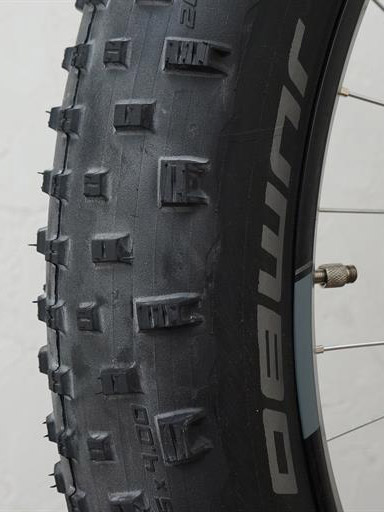It was back in May that we first saw how much variation there was in the rolling resistance from one fat bike tire to the next thanks to the great independent testing of Jarno Bierman and his Bicycle Rolling Resistance lab. The topic came up soon after of what impact converting to tubeless would have on the setup, being able to drop those big heavy butyl tubes. So this time back Bierman picked the two tires with the lowest rolling resistance and one of the heaviest with the tallest knobs to put back on the drum and see what could be gained by dropping almost 400g of tube out of the mix…
Unsurprisingly the removal of the tube had a measurable impact on rolling resistance, and a side benefit was obviously a drop in weight too. Using a tubeless rim, the conversions in this test protocol dropped the (relatively light) 390g Schwalbe butyl inner tube and replaced it with a 10g tubeless valve and 60g of sealant for each tire, saving 320g per wheel. Dropping 25% off the weight of the tire/tube combo shouldn’t be underestimated for giving a better ride feel, but a quantifiable drop in rolling resistance was the goal here.

The energy savings amounted to about 4-5 watts around 12-20psi, but since fat bikes run even lower than that Bierman took the test down to just 6psi. That’s where he noticed that the lower he went the bigger the savings. So while resistance does increase at those ultra-low pressures where the tire is getting more and more grip, the benefits of tubeless increase. The change wasn’t linear either, with a 17% reduction at 6psi vs. 14% reduction at 16 psi. That’s good news for fat bikers. Going tubeless has even more effect on reducing rolling resistance than it does on a regular mountain bike.
Savings were pretty similar across all of the three tires tested, but the 4″ Schwalbe Jumbo Jim LiteSkin remains the fastest of the bunch. As Bierman puts it, “some smaller 29 x 2.25 MTB tires even have a higher rolling resistance than the tubeless Jumbo Jim LiteSkin which is just crazy.” The second place 4″ Specialized Fast Trak Fat comes in close behind, with even more of an improvement going tubeless. The more aggressive 45NRTH Van Helga had similar results, which Bierman says suggests that most other fat tires should improve as well.
The conclusion from the Bicycle Rolling Resistance lab:”tubeless is a necessity on fat bikes if you value speed.” They think that for most fat bikers running low pressures, you can easily earn back an extra 10% of your usable power output, just by ditching the tubes. That sounds like a no brainer for us to have more fun and longer adventures on the bike.
We’d like to thank people like Bicycle Rolling Resistance who are doing truly independent testing like this, and the companies who sponsor their work through ads, some even though they have nothing direct to gain from more efficient tires.






